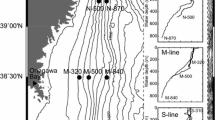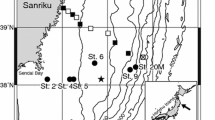Abstract
We examined the effects of mass sedimentation events caused by the 2011 off the Pacific coast of Tohoku Earthquake on abundances and vertical distributions of prokaryotes and metazoan meiofauna in sediments, using sediment cores collected from eight bathyal stations off Tohoku 1 year after the M9.0 earthquake. Event deposits 1–7 cm thick were observed at the topmost part of the sediment cores at all sampling stations. At some stations, prokaryotic cell abundances were lower in the surface event-deposit layers compared to those in deeper sediments. These variations were explained by environmental parameters such as a dimensionless sorting factor and mean grain size, suggesting that turbidite sedimentation affected prokaryotic cell abundances. Nematodes had anomalously higher subsurface abundances at the stations where subsurface peak prokaryotic cell numbers were observed, whereas copepods always showed peak densities in the sediment surface layer. Although there are no available data for prokaryotic cell abundances and meiofaunal densities before the earthquake from the same sites, it is likely that the subsurface peaks in prokaryotic cell numbers and nematode densities resulted from the sedimentation events. The effects of sedimentation events on the organisms were observed 1 year after the earthquake, indicating that episodic sedimentation events on scales of several centimeters have a large effect on small organisms inhabiting sediments.







Similar content being viewed by others
References
Ahnert A, Schriever G (2001) Response of abyssal Copepoda Harpacticoida (Crustacea) and other meiobenthos to an artificial disturbance and its bearing on future mining for polymetallic nodules. Deep-Sea Res II 48:3779–3794
Alongi DM (1985) Effects of physical disturbance on population dynamics and trophic interactions among microbes and meiofauna. J Mar Res 43:351–364
Altaff K, Sugumaran J, Naveed MS (2005) Impact of tsunami on meiofauna of Marina beach, Chennai, India. Curr Sci India 89:34–38
Anderson MJ, Gorley RN, Clarke KR (2008) PERMANOVA+ for PRIMER: guide to software and statistical methods. PRIMER-E, Plymouth
Arai K (2015) Possibility for the occurrence of tsunami-generated turbidity currents: Insights from the 2011 Tohoku-Oki Earthquake. Dissertation, Chiba University, pp 131
Arai K, Naruse H, Miura R, Kawamura K, Hino R, Ito Y, Inazu D, Yokokawa M, Izumi N, Murayama M, Kasaya T (2013) Tsunami-generated turbidity current of the 2011 Tohoku-Oki earthquake. Geology. doi:10.1130/G34777.1
Chen JC, Kuo YZ (1992) Effects of ammonia on growth and molting of Penaeus japonicas juveniles. Aquaculture 104:249–260
D’Hondt S, Jorgensen BB, Miller DJ et al (2004) Distributions of microbial activities in deep subseafloor sediments. Science 306:2216–2221
Danovaro R (2010) Methods for the study of Deep-sea sediments, their functioning and biodiversity. CRC Press, New York
Danovaro R, Fabiano M, Della Croce N (1993) Labile organic matter and microbial biomasses in deep-sea sediments (Eastern Mediterranean Sea). Deep Sea Res I 40:953–965
Danovaro R, Fabiano M, Albertelli G, Della Croce N (1995) Vertical distribution of meiobenthos in bathyal sediments of the eastern Mediterranean Sea: relationship with labile organic matter and bacterial biomasses. Mar Ecol 16:103–116
Danovaro R, Gambi C, Della Croce N (2002) Meiofauna hotspot in the Atacama Trench, eastern South Pacific Ocean. Deep Sea Res I 49:843–857
Danovaro R, Dell’Anno A, Corinaldesi C, Magagnini M, Noble R, Tamburini C, Weinbauer M (2008) Major viral impact on the functioning of benthic deep-sea ecosystems. Nature 454:1084–1088
Fujii Y, Satake K, Sakai S, Shinohara M, Kanazawa T (2011) Tsunami source of the 2011 off the Pacific coast of Tohoku earthquake. Earth Planets Space 63:815–820
Fujikura K, Watanabe H, Miyamoto N, Furushima Y, Nomaki H et al (2012) Impact by the mega-earthquake: the 2011 Mw 9.0 Tohoku-Oki Earthquake, on marine ecosystem in Japan Trench, off Sanriku. Jpn J Benthol 66:129–130 (in Japanese)
Fujita K, Ohta S (1989) Spatial structure within a dense bed of the brittle star Ophiura sarsi (Ophiuroidea: Echinodermata) in the bathyal zone off Otsuchi, northeastern Japan. J Oceanogr Soc Jpn 45:289–330
Giere O (2009) Meiobenthology, 2nd edn. Springer, Berlin
Gooday AJ, Lambshead PJD (1989) Influence of seasonally deposited phytodetritus on benthic foraminiferal populations in the bathyal northeast Atlantic: the species response. Mar Ecol Prog Ser 58:53–67
Gooday AJ, Bernhard JM, Levin LA, Suhr SB (2000) Foraminifera in the Arabian Sea oxygen minimum zone and other oxygen-deficient settings: taxonomic composition, diversity, and relation to metazoan faunas. Deep Sea Res II 47:25–54
Graf G (1987) Benthic energy flow during a simulated autumn bloom sedimentation. Mar Ecol Prog Ser 39:23–29
Ikehara K, Irino T, Usami K, Jenkins R, Omura A, Ashi J (2014) Possible submarine tsunami deposits on the outer shelf of Sendai Bay, Japan resulting from the 2011 earthquake and tsunami off the Pacific coast of Tohoku. Mar Geol 358:120–127
Ingole BS, Goltekar NR, Gonsalves S, Ansari ZA (2005) Recovery of deep-sea meiofauna after artificial disturbance in the Central Indian Basin. Mar Georesour Geotec 23:253–266
Jørgensen BB, Glud RN, Holby O (2005) Oxygen distribution and bioirrigation in Arctic fjord sediments (Svalbard, Barents Sea). Mar Ecol Prog Ser 292:85–95
Jorissen FJ, de Stigter HC, Widmark GV (1995) A conceptual model explaining benthic foraminiferal microhabitats. Mar Micropaleontol 26:3–15
Kallmeyer J, Pockalny R, Adhikari RR, Smith DC, D’Hondt S (2012) Global distribution of microbial abundance and biomass in subseafloor sediment. Proc Natl Acad Sci USA 119:16213–16216
Kalogeropoulou V, Bett BJ, Gooday AJ, Lampadariou N, Martinez Arbizu P, Vanreusel A (2010) Temporal changes (1989–1999) in deep-sea metazoan meiofaunal assemblages on the Porcupine Abyssal Plain, NE Atlantic. Deep Sea Res II 57:1383–1395
Kawagucci S, Yoshida YT, Noguchi T, Honda MC, Uchida H, Ishibashi H, Nakagawa F, Tsunogai U, Okamura K, Takaki Y, Nunoura T, Miyazaki J, Hirai M, Lin W, Kitazato H, Takai K (2012) Disturbance of deep-sea environments induced by the M9.0 Tohoku Earthquake. Sci Rep. doi:10.1038/srep00270
Khripounoff A, Caprais JC, Crassous P (2006) Geochemical and biological recovery of the disturbed seafloor in polymetallic nodule fields of the Clipperton–Clarion Fracture Zone (CCFZ) at 5000-m depth. Limnol Oceanogr 51:2033–2041
Kitahashi T, Watanabe H, Jenkins RG, Kojima S, Shimanaga M (2015) Deep-sea meiofauna after the 2011 earthquake off the Pacific coast of Tohoku: comparison with before and other trench slopes around Japan. J Oceanogr (submitted)
Kitahashi T, Jenkins RG, Nomaki H, Shimanaga M, Fujikura K, Kojima S (2014) Effect of the 2011 Tohoku Earthquake on deep-sea meiofaunal assemblages inhabiting the landward slope of the Japan Trench. Mar Geol 358:128–137
Koho KA, Garcia R, de Stigter HC, Epping E, Kouwenhoven TJ, van der Zwaan GJ (2008) Sedimentary labile organic carbon and pore water redox control on species distribution of benthic foraminifera: a case study from Lisbon–Setubal Canyon (southern Portugal). Progr Oceanogr 79:55–82
Kojima S, Ohta S (1989) Patterns of bottom environments and macrobenthos communities along the depth gradient in the bathyal zone off Sanriku, northwestern Pacific. J Oceanogr Soc Jpn 45:95–105
Kojima S, Ohta S (1990) Seasonal variations of the deep-sea macrobenthos communities in the coastal and bathyal zones off Sanriku, northeastern Japan. J Oceanogr Soc Jpn 46:250–260
Lambshead PJD, Tietjen J, Glover A, Ferrero T, Thistle D, Gooday AJ (2001) Impact of large-scale natural physical disturbance on the diversity of deep-sea North Atlantic nematodes. Mar Ecol Prog Ser 214:121–126
Middelboe M, Glud RN, Wenzhoefer F, Oguri K, Kitazato H (2006) Spatial distribution and activity of viruses in the deep-sea sediments of Sagami Bay, Japan. Deep Sea Res I 53:1–13
Middelboe M, Glud RN, Filippini M (2011) Viral abundance and activity in the deep sub-seafloor biosphere. Aquat Microb Ecol 63:1–8
Miljutin DM, Miljutina MA, Martinez Arzibu P, Galeron J (2011) Deep-sea nematode assemblage has not recovered 26 years after experimental mining of polymetallic nodules (Clarion–Clipperton Fracture Zone, Tropical Eastern Pacific). Deep Sea Res I 58:885–897
Moodley L, Chen G, Heip C, Vincx M (2000) Vertical distribution of meiofauna in sediments from contrasting sites in the Adriatic Sea: clues to the role of abiotic versus biotic control. Ophelia 53:203–212
Nomaki H, Arai K, Suga H, Toyofuku T, Wakita M, Nunoura T, Oguri K, Kasaya T, Watanabe S (2015) Sedimentary organic matter contents and porewater chemistry at the upper bathyal depths influenced by the 2011 off the Pacific coast of Tohoku earthquake and tsunami. J Oceanogr (submitted)
Ostrensky A, Wasielesky W (1995) Acute toxicity of ammonia to various life stages of the São Paulo shrimp, Penaeus paulensis Pérez-Farfante, 1967. Aquaculture 132:339–347
Peck LS, Brockington S, Vanhove S, Beghyn M (1999) Community recovery following catastrophic iceberg impacts in a soft-sediment shallow-water site at Signy Island, Antarctica. Mar Ecol Prog Ser 186:1–8
Racotta IS, Hernández-Herrera R (2000) Metabolic responses of the white shrimp, Penaeus vannamei, to ambient ammonia. Comp Biochem Phys A 125:437–443
Sato M, Ishikawa T, Ujihara N, Yoshida S, Fujita M, Mochizuki M, Asada A (2011) Displacement above the hypocenter of the 2011 Tohoku-oki earthquake. Science 332:1395
Schratzberger M, Warwick RM (1998) Effects of physical disturbance on nematode communities in sand and mud: a microcosm experiment. Mar Biol 130:643–650
Seike K, Shirai K, Kogure Y (2013) Disturbance of shallow marine soft-bottom environments and megabenthos assemblages by a huge tsunami induced by the 2011 M9.0 Tohoku-oki earthquake. PLoS One 8:e65417
Shimanaga M, Shirayama Y, Kitazato H (2005) Seasonal patterns of reproductive activities among deep-sea benthic copepod species in the bathyal Sagami Bay, central Japan. Hydrobiologia 533:29–39
Shimanaga M, Nomaki H, Suetsugu K, Murayama M, Kitazato H (2007) Standing stock of deep-sea metazoan meiofauna in the Sulu Sea and adjacent areas. Deep Sea Res II 54:131–144
Shirayama Y (1984a) Vertical distribution of meiobenthos in the sediment profile in bathyal, abyssal and hadal deep sea systems of the Western Pacific. Oceanol Acta 7:123–129
Shirayama Y (1984b) The abundance of deep sea meiobenthos in the Western Pacific in relation to environmental factors. Oceanol Acta 7:113–121
Shirayama Y, Kojima S (1994) Abundance of deep-sea meiobenthos off Sanriku, Northeastern Japan. J Oceanogr 50:109–117
Shirayama Y, Ohta S (1990) Meiofauna in cold-seep community off Hatsushima, central Japan. J Oceanogr Soc Jap 46:118–124
Westheide W, Purschke G (1988) Organism processing. In: Higgins RP, Thiel H (eds) Introduction to the study of Meiofauna. Smithsonian Institute Press, Washington, DC, pp 146–160
Yamada K, Terakura M, Tsukawaki S (2014) The impact on bottom sediments and ostracods in the Khlong Thom River mouth following the 2004 Indian Ocean tsunami. Paleontol Res 18:104–117
Yamanaka Y, Kikuchi M (2004) Asperity map along the subduction zone in northeastern Japan inferred from regional seismic data. J Geophys Res 109:B07307
Yanagawa K, Morono Y, Yoshida-Takashima Y, Eitoku M, Sunamura M, Inagaki F, Imachi H, Takai K, Nunoura T (2014) Variability of subseafloor viral abundance at the geographically and geologically distinct continental margins. FEMS Microbiol Ecol 88:60–68
Acknowledgments
We are grateful to the crews, technicians, and scientists of R/V Mirai for their collaboration during cruise MR12-E02. We also thank the editors and three anonymous reviewers for their constructive comments on this manuscript. This study was supported by the Tohoku Ecosystem-Associated Marine Sciences (TEAMS) Fund of the Ministry of Education, Culture, Sports, Science and Technology, Japan (MEXT).
Author information
Authors and Affiliations
Corresponding author
Rights and permissions
About this article
Cite this article
Nomaki, H., Mochizuki, T., Kitahashi, T. et al. Effects of mass sedimentation events after the 2011 off the Pacific coast of Tohoku Earthquake on benthic prokaryotes and meiofauna inhabiting the upper bathyal sediments. J Oceanogr 72, 113–128 (2016). https://doi.org/10.1007/s10872-015-0293-5
Received:
Revised:
Accepted:
Published:
Issue Date:
DOI: https://doi.org/10.1007/s10872-015-0293-5




